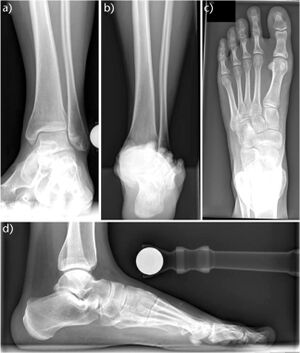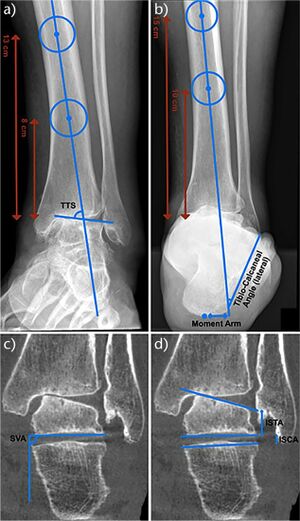◔
Hindfoot Radiographs
From WikiMSK
This article is a stub.

Plain weight-bearing radiographs of a healthy foot and ankle: a) anteroposterior view; b) hindfoot alignment view; c) dorso-plantar view; d) lateral view.[1]
The subtalar joint is difficult to evaluate radiographically. Usually a weight-bearing AP or mortise view along with a lateral view is sufficient for foot and ankle assessment.

Hindfoot alignment measurements using plain weight-bearing radiographs and weight-bearing CT scans: a) anteroposterior view, tibiotalar surface angle (TTS) is used to measure inclination of the talus in relation to the tibial axis; b) hindfoot alignment view, the moment arm of the calcaneus and lateral tibio-calcaneal angle are used to assess the hindfoot alignment; c) weight-bearing CT scan, subtalar vertical angle (SVA) is used to measure the subtalar joint axis relative to the ground; d) weight-bearing CT scan, inftal-subtal angle (ISTA) is used to assess the talar morphology and inftal-supcal angle (ISCA) to determine the inclination of the calcaneus in relation to the talus.[1]
- Weight-bearing AP or mortise view
- Weight-bearing lateral view
- Dorso-plantar view allows assessment of the talo-calcaneal angle. This angle is increased in flat feet and reduced in cavus feet.
- Hindfoot view (e.g. hindfoot alignment view, long axial view). This allows assessment of the hindfoot axis in chronic ankle instability
- Stress radiographs. These aren't generally recommended. Intra-operatively however they can be used to distinguish between ankle and subtalar joint instability
- Harries-Beth, Broden, lateral oblique axial views. These can allows proper assessment of the subtalar joint
- Hindfoot alignment view.
- Long axial view. Also allows viewing hindfoot alignemnt
- Subtalar view

